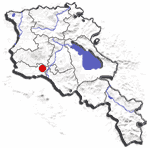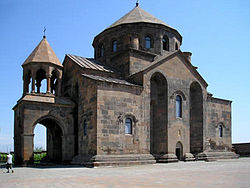Etchmiadzin Cathedral




Echmiadzin or Ejmiatsin (Armenian: Էջմիածին) is the holiest town in Armenia and the headquarters of the katholikos, the head of the Armenian Apostolic Church. It is located in the Armavir province, about 20 km west from Yerevan.
The town originated as Vardkesavan in the 4th or 3rd century BC. King Vagharsh (117-140) had the name changed to Vagharshapat (Armenian: Վաղարշապատ), which still persists as the official appellation of the town. Several decades later the town became the capital of Armenia and remained the country's most important city until the 4th century AD.
Historically, the focal point of the town is the Echmiadzin Cathedral. It was originally built by Saint Gregory the Illuminator as a vaulted basilica in 301-303, when Armenia was the only country in the world recognising Christianity as a state religion. According to the 5th-century Armenian annals, St Gregory had a vision of Christ descending from heaven and striking the earth with a golden hammer to show where the cathedral should be built. Hence, the patriarch gave the church and the town the new name of Echmiadzin, which may be translated as "the place where the Only Begotten descended".
In 480, Vahan Mamikonian, the Roman governor of Armenia, ordered the dilapidated basilica to be replaced with a new cruciform church. In 618, the wooden dome was replaced with a stone one, resting on four massive pillars linked to exterior walls by arcades. This was the church much as it is today. Murals in the interior and extravagant rotundas surmounting the apses appeared in the early 18th century. A three-tier belfry was constructed half a century earlier. The cathedral formerly boasted the largest collection of Armenian medieval manuscripts, but these were lately handed over to the Matenadaran.
Apart from the cathedral, the town contains two highly important and very ancient churches. The church of St Gayane, distinguished by its harmonious proportions, was constructed in 630 and underwent enlargement in the 17th century, when they rebuilt the dome and added a porch. The church of St Hripsime was built in 618 and survives basically unchanged. These two churches, the cathedral and the nearby archaeological site of Zvartnots are listed among the UNESCO World Heritage Sites.
External links
- UNESCO World Heritage Site profile
- The Holy City of Etchmiadzin - article by the Armenian Enlightment Chronicle
- Details and illustrations
